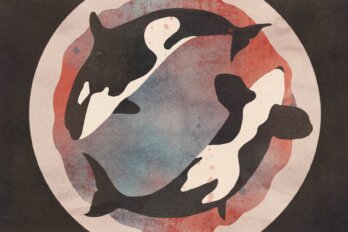Once upon a time, two baby polar bears lived with their mother on the coast of Hudson Bay in Manitoba. Under her care, the brother and sister loved to wrestle and play in the spruce and tamarack. Then, in September 2014, a team of surveyors spotted the eight-month-old cubs—without their mother—three kilometres from a male polar bear, who was dead from a severed artery. A twenty-five-kilometre search for the mother ensued, but the officer called in to investigate spotted only other hungry predators. He decided to take in the pair, Blizzard and Star, who were flown to Winnipeg the next day.
The city’s Assiniboine Park Zoo does double duty as a polar bear orphanage. Since it opened in 2012, the International Polar Bear Conservation Centre has adopted five cubs. Many of them come from near Churchill, where human–polar bear encounters sometimes turn violent, leaving cubs—who would ordinarily be cared for by their mothers until they’re two-and-a-half—orphans. A previous nine-year attempt to pair orphans with foster-mother bears in the wild was stopped in 2010 because not enough cubs survived.
Getting a polar bear to Winnipeg is easier than you’d think. Place the cub in a cage with no sharp edges, load it into the hold of a Calm Air plane, cool the air to ten degrees, then, after the crew alerts the forty-odd passengers to the unlikely cargo, answer any questions. “Travellers are always excited when they see one of them in a crate,” says Brian Joseph, the zoo’s director and the veterinarian who brought one of the cubs to Winnipeg. “But little polar bears are still polar bears. They’re not cuddly, they’re not toys, they’re not pets.”
When Blizzard and Star arrived at the centre, they scarfed down chunks of feline diet—processed food made mostly of horsemeat—before plodding out of their cages and into a holding cell. After a thirty-day quarantine, they moved to the outdoor enclosure where they soon met Humphrey, another cub their age. Upstairs in the kitchen, fridges (“animal food only” on the door) hold buckets of herring and tullibee. Joseph notes the high quality of the fresh fish with the wry amusement of a pet owner whose dog eats healthier than he does. Vials of glitter are kept in the feeding area: each bear gets a different colour with his or her food (individual hormone levels are monitored through the sparkly poop).
Eighty-two percent of all mammals in zoos and aquariums are born in captivity, but Joseph hopes the orphans will inspire children to care about bears and, in turn, about conserving their natural habitat. In Winnipeg, they roam 8,557 square metres (respectable for an urban zoo), yet in the wild they might have a thousand square kilometres of tundra and sea ice. Here, the rocks are shotcrete. The greenery—spotted with patches of brown—would be lusher were it not trampled by 3,500 kilograms of Ursus maritimus daily. The blueberries hidden inside the ice don’t quite replicate the real thing. For bears and humans alike, the highlight of the exhibit is a swimming pool with a clear acrylic walkway underneath for visitors. (When the pool is closed for repairs or cleaning, the bears bang on the door: let us in.)
And though Blizzard and Star may live up to forty years, longer than they would in the wild, they will not go back to the Arctic. No mother has taught them to hunt seals. But wherever they go, whether it’s to another zoo or a sanctuary, they will remain the legal property of Manitoba, which will ensure they don’t languish in sub-standard conditions. When zoos are bad for polar bears, they are horrifying: take the example of Arturo, whom the sanctuary attempted to repatriate last year from Mendoza, Argentina, after a petition to fly the “world’s saddest animal” home secured half a million signatures.
Back in the orphan pen, three cubs laze under a bright afternoon sun as parents push strollers toward the enclosure. Blizzard and Star are perched high on the rocks. “If you asked those two to fill out a questionnaire—would they rather be picked up and brought here, or be eaten by wolves—I don’t think they would check the second box,” Joseph says. Star yawns, while her brother rolls over. Nap time.
This appeared in the November 2015 issue.





